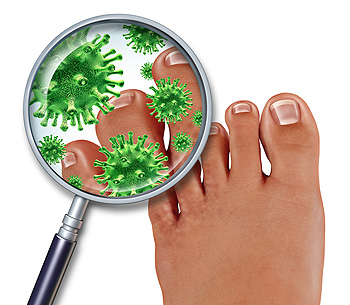 Athlete’s foot is a fungal infection that occurs on the feet. Typically, it’s contagious between people and can spread to the toenails as well. The fungus can thrive on the foot because it prefers areas that are warm and moist. People who wear poorly ventilated shoes, such as those that are plastic-lined, or wear socks that do not absorb sweat are more likely to develop athlete’s foot. It’s important to wear shower shoes while in public showers or locker rooms to help prevent infection. Diabetics should be wary as they may have a harder time dealing with the infection because of poor blood circulation. Prevention is key; wearing well-ventilated shoes and moisture wicking socks can help keep the feet dry. Especially be sure to keep the space between your toes dry, as this area can harbor fungus. Another way to keep the feet dry is using a talcum powder on the foot. Athlete’s foot can be a difficult condition to deal with, but podiatrists can offer a number of effective treatment options.
Athlete’s foot is a fungal infection that occurs on the feet. Typically, it’s contagious between people and can spread to the toenails as well. The fungus can thrive on the foot because it prefers areas that are warm and moist. People who wear poorly ventilated shoes, such as those that are plastic-lined, or wear socks that do not absorb sweat are more likely to develop athlete’s foot. It’s important to wear shower shoes while in public showers or locker rooms to help prevent infection. Diabetics should be wary as they may have a harder time dealing with the infection because of poor blood circulation. Prevention is key; wearing well-ventilated shoes and moisture wicking socks can help keep the feet dry. Especially be sure to keep the space between your toes dry, as this area can harbor fungus. Another way to keep the feet dry is using a talcum powder on the foot. Athlete’s foot can be a difficult condition to deal with, but podiatrists can offer a number of effective treatment options.
Athlete’s foot is an inconvenient condition that can be easily reduced with the proper treatment. If you have any concerns about your feet and ankles, contact one of our podiatrists from William Street Podiatry. Our doctors will treat your foot and ankle needs.
Athlete’s Foot: The Sole Story
Athlete's foot, also known as tinea pedis, can be an extremely contagious foot infection. It is commonly contracted in public changing areas and bathrooms, dormitory style living quarters, around locker rooms and public swimming pools, or anywhere your feet often come into contact with other people.
Solutions to Combat Athlete’s Foot
- Hydrate your feet by using lotion
- Exfoliate
- Buff off nails
- Use of anti-fungal products
- Examine your feet and visit your doctor if any suspicious blisters or cuts develop
Athlete’s foot can cause many irritating symptoms such as dry and flaking skin, itching, and redness. Some more severe symptoms can include bleeding and cracked skin, intense itching and burning, and even pain when walking. In the worst cases, Athlete’s foot can cause blistering as well. Speak to your podiatrist for a better understanding of the different causes of Athlete’s foot, as well as help in determining which treatment options are best for you.
If you have any questions please feel free to contact one of our offices located in William Street in New York, NY, Forest Hills, NY, and Broadway in New York, NY . We offer the newest diagnostic and treatment technologies for all your foot and ankle needs.

